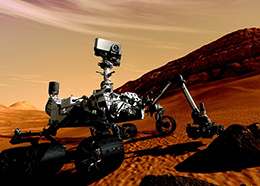Making Mars a little less alien

The chemistry that makes up the surface of Mars could soon become a little less alien thanks to research from an academic at The Australian National University.
Dr. Penny King, from the ANU College of �鶹��Ժical and Mathematical Sciences, is heading to NASA’s Jet Propulsion Laboratory in California tomorrow to work on the Mars Science Laboratory mission, NASA’s latest rover mission to Mars.
“It is the opportunity of a lifetime to be involved in a mission that explores new areas in our solar system,” Dr. King said.
“Based on past missions, we expect to find out that the Martian surface is more diverse and interesting than we could ever have imagined.”
Dr. King will be working as a Science Co-Investigator on an instrument on the ‘Curiosity’ rover, called the alpha-particle X-ray spectrometer (APXS).
Data from the APXS, which is sponsored by the Canadian Space Agency and NASA, will help scientists determine the chemical makeup of the Martian surface providing the information needed to understand the history and past environment on Mars.
“The Curiosity rover will search for past life, specifically traces of organic matter on Mars. We will take a close look at the Gale Crater which likely has some of the ingredients that we think are important to life including water, energy and carbon, as well as rocks that might preserve organic matter,” Dr. King said.
Curiosity will descend towards the Martian surface on August 6 at 3.31pm EST using a landing approach that involves rocket thrusters, a parachute, separation of a heat shield, a ground sensing radar, and a sky crane device that will lower the rover onto the surface of the planet and fly away.
The Tidbinbilla Tracking Station will be responsible for communications during the landing.
“I am looking forward to being at the Jet Propulsion Laboratory in California and receiving the information on a successful landing direct from Tidbinbilla Tracking Station near my home town of Canberra,” Dr. King said.
“When Curiosity lands on Mars it will be a culmination of many years of work for scientists and engineers around the world.”
Provided by Australian National University




















